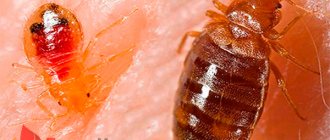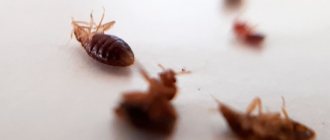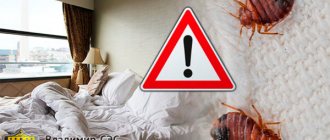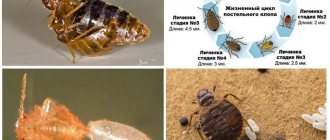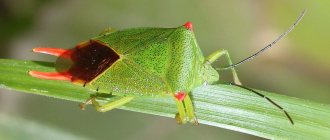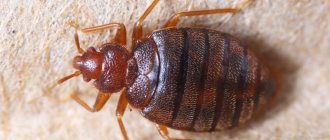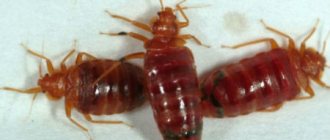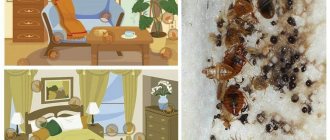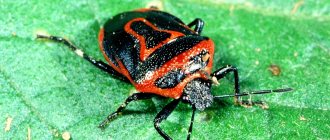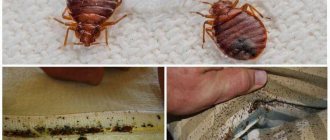- By Vil Malinoshevsky
- About bedbugs
Very often in our work we come across people who were sure (or wanted to believe) that there are means that bedbugs are afraid of and with which these parasites can be scared away from the apartment. Such products are the dream of many, because if they really effectively repelled bedbugs, then with their help it would be possible to get rid of parasites without the need to treat the apartment with chemicals, which many are afraid of.
Bed bugs in an open shelter, from which it is almost impossible to drive them out ©Mario David Bazan
It is very significant that all these people sooner or later turn to pest control services to poison bedbugs. That is, it is obvious that they failed to scare away the bedbugs and had to use really effective measures.
We always ask our clients what means they used to poison bedbugs before contacting us. We need this, at a minimum, in order to select a drug with an active substance that has not been used before in a particular apartment. And although many people do not admit that they have tried to repel bedbugs, many report that they have used various herbs, ultrasonic repellers, essential oils and the like.
Approximately half of our customers told us that they had dabbled in such supposedly “repellent” products. If not the entire remaining half, then a significant part also probably did this, but they didn’t admit it to us.
Let's now find out what bedbugs are really afraid of, what they are not afraid of, and whether they can be removed with some repellents.
Will bedbugs go away if you use the products they are afraid of?
Let's start with the main thing: bed bugs cannot be scared away from the apartment . Even though there are things that bedbugs are truly afraid of, there are no ways to apply these things in a way that will drive bedbugs away. Practice shows (and theory proves this) that you can either kill bedbugs indoors or continue to feed them with your blood.
The video below shows treatment in an apartment, in which they tried to repel bedbugs first with tansy and then with essential oils:
We do not know of a single case where people, after the fact of infestation of an apartment, managed to scare bedbugs out of it. We have encountered situations that seemed similar to this, but most likely it was not a matter of scaring.
For example, there was a case when a person caught a bedbug on his bed, crushed it, sprinkled vinegar in the corners and never saw any more bedbugs at home. The man believes that it was with vinegar that he was able to repel bedbugs. We believe that in this situation, a person brought home one bedbug on his clothes or in a bag, by a lucky chance he saw this one bedbug, killed it, and the vinegar no longer affected anyone, simply because there was not a single living bedbug left in the room. That is, in this case, there was no fact of infection of the apartment: bedbugs did not begin to multiply here.
If the bugs in the apartment have clearly begun to multiply, it is impossible to scare them all away, but not destroy them.
Specialized insecticidal preparations
Despite what is written above, folk remedies are simply not able to compare in effectiveness with modern insecticides. Especially if you consider the variety of special means for combating bed bugs presented on today's Russian market. Their classification is carried out according to various criteria: active ingredient, dosage, container, etc.
But most often, for such purposes, a parameter such as the release form is used. We are talking about four main groups of such drugs, each of which deserves separate consideration.
Emulsion and suspension
One of the most popular forms of release of insecticidal agents. Provides for the preparation of a solution based on an emulsion or suspension for treating the habitats and movement of bedbugs. The latter is performed with various spray guns or ordinary brushes/brushes.
The emulsion/suspension base usually uses very potent active substances. Bedbugs do not like them and are afraid of them, since any contact leads to the death of the parasite. Among the most popular insecticidal preparations produced in the form of an emulsion, it is necessary to highlight the following:
- Likhodey;
- Ram;
- Get Total;
- Dobrokhim FOS;
- Jurax;
- Medilis Cyper;
- Agran;
- Cypermethrin;
- Forssyth;
- Tetracine and many others.
The above list can hardly be called exhaustive. Moreover, new preparations for the destruction of bed bugs and other insects, produced in the form of an emulsion, appear on the domestic market almost constantly. This makes the choice of potential buyers even wider and more diverse.
Spray
The second most popular form of insecticide release is deservedly considered to be various sprays. They are supplied in special aerosol cans, which makes the product very simple and convenient for application by spraying in the habitats and mass movement of bed bugs.
The classic “Dichlorvos” has long been considered the most common insecticide in spray form. But today the choice of such drugs is much wider and includes: Raptor, Combat, Primu-U, Antiklop, Carbozol, etc. A prerequisite for the practical use of sprays is compliance with safety precautions when working with the drug. The main requirement is to use a respirator designed to protect the human respiratory system during spraying.
Gel
Unlike an emulsion, an insecticide in the form of a gel does not require prior dilution with water. The composition is supplied ready for use and is applied to areas where bed bugs are especially likely to appear. We are talking about the bed, cabinets and drawers next to a person’s sleeping place, near the baseboards and in other similar places.
A distinctive feature of most gels is a fairly strong and pungent odor. Therefore, operation of a room treated with an insecticidal preparation is possible only after thorough ventilation. Among the most popular gels against bed bugs in Russia, it is necessary to highlight the following: Domovoy, Absolut, Fas and Fumitox.
The Vladimir SES sanitary service is skeptical about the use of gels to combat bed bugs. Our opinion: gels can be effectively used to treat the ventilation shafts of an apartment from the inside to prevent the infestation of bedbugs from neighbors. No more.
Chalk, glue, powder and smoke bomb
A simple and easy-to-use form of release for a large group of insecticidal agents that are widely used to kill bedbugs. Among crayons, several preparations are most common: Mashenka, Nika-1, Clean House and others. This category of means for fighting bedbugs includes Alt glue, an equally popular composition among domestic consumers for catching bedbugs and other insects.
The basis of powdered preparations for the destruction of bed bugs is sometimes the natural substance diatomite. The insecticide also contains various additives that increase the effectiveness of insect control and the ease of practical use of the product. The most popular powders for killing bedbugs are: Phenaxin, Hector, Fas-Double, Lethal force.
Smoke bombs deserve special mention, as they are deservedly among the most effective drugs against bed bugs. The most popular of them is City. The product is used very simply: it is set on fire in the room where bedbugs are found. As a result of combustion, smoke is formed that fills the entire internal space, including the most secluded corners. Such hot smoke contains an insecticide (as when operating a hot fog generator), so burning a bomb indoors has lethal consequences for insects.
Ultrasonic devices and electro-fumigators
In recent years, technical means to combat bed bugs have become increasingly widespread. We are talking about special ultrasonic devices and electric fumigators that operate from the electrical network.
The effectiveness of their use for the destruction of bedbugs is not always high, but with proper use and at low levels of infestation, it is quite possible to achieve success and some efficiency. The main condition for this is a serious approach to choosing a suitable device, the number of which is constantly increasing on the market. The latter circumstance clearly shows that such means of combating bed bugs are in obvious demand.
Why is it impossible to scare bedbugs out of an apartment?
There are several reasons for the fundamental impossibility of driving bedbugs out of an apartment. The first of them: bedbugs have nowhere to go. They do not know that they can leave this room to join their neighbors, because most of them do not move such distances in their entire lives.
There are times when they can crawl along the heating riser every night from the apartment above to you, and crawl back there the next morning. However, this is rare, and most bedbugs only know the route from their daytime hiding place to and from their bed. If something appears in the apartment that they are afraid of, they will prefer to simply endure it in shelters, and then, when they are very hungry, they will crawl out, despite the unpleasant smell for them.
Sometimes people get the false impression that if bedbugs are poisoned by neighbors, then the insects are afraid of the product and run to neighboring apartments. In fact, when baited with chemical insecticides, bedbugs do not run anywhere. They can crawl out of their shelters, they can die in these shelters, but, in fact, they cannot escape from the room.
Indeed, migration occurs when people systematically open up bedbug hiding places. Insects try to hide in new dark secluded places, people open them up too, insects crawl into new shelters and some of them end up in cracks in the walls, in sockets and electrical wiring grooves, in ventilation, and these are passages into neighbors’ apartments. Of these, this part of the bedbugs gets into the neighbors.
But such a situation is possible when neighbors either very carefully open up all the nests of bedbugs, which rarely happens (more often people are lazy and don’t do this), or when neighbors make repairs and strip all the walls, floors, and ceilings down to concrete, that is, they simply deprive bedbugs of shelter . Bedbugs, accordingly, can only hide in the paths that lead to your home, and along these paths they enter your apartment. It looks like they are "running" out of fear, but in reality they are just doing what they have been doing all along - hiding in the safest places.
If bedbugs still have places to hide specifically in your apartment, you won’t be able to drive these parasites away with any repellents. If they are afraid of something, they will simply hide in these places. This will not make things any easier for homeowners.
The second reason: bedbugs quickly adapt to many repellents, even if they were initially afraid of such drugs. This is very clearly seen in practice: if you place a wormwood branch under an uninfected bed, then for a day or two the parasites will not climb onto this bed. But then, one or two at a time, they will begin to get out from behind the baseboards, go around this wormwood and climb onto the bed, and when each individual repeats this two or three times, it will stop paying attention to this remedy. This will already happen for the third reason: hunger is stronger than fear.
This rule works throughout the animal world, and in humans too. For a day or two, while the bugs are not hungry, they may not bite if they are afraid of some kind of remedy. When they are really hungry, they will be able to overcome their fear in order to find food.
It is well known that very hungry bedbugs can get out and bite even in the light, although in general they are more afraid of light than most other environmental factors. And if they can bite in the light, then they will also bite if they smell bleach, tansy or some kind of essential oil.
And the fourth reason: not all products that are considered to repel bedbugs actually repel them. There are clear dummies, for example, ultrasonic or electromagnetic repellers. There are products that bedbugs are afraid of, but to which they get used. There are tools whose operating principles people do not fully understand.
For example, the same vinegar: if it gets on a bug, it kills it. But if you simply sprinkle furniture and walls with vinegar, the smell will repel bedbugs for two to three days. After this, the parasites will get used to it and will calmly run around the baseboards that smell of vinegar. Moreover, the smell of vinegar will weaken over time.
Hence we conclude: bedbugs cannot be driven out of the apartment by any means. Even if they are afraid of certain smells, or, for example, light, then for a short time you can reduce the strength and frequency of their bites, but after a few days everything will return to its place.
Now let's go specifically through the most well-known means, phenomena and environmental factors that bedbugs are supposedly afraid of.
Strong aromas
If bedbugs are not constantly repelled, they will infest the apartment and the fight against them will become more difficult in the future. When parasitic colonies are detected, it is important to establish possible ways of their penetration into the living space in order to prevent new colonization in the future.
Domestic bugs are very frightened of certain odors, which are detected by developed olfactory receptors. For natural repellents, use fresh herbs.
Sagebrush
An effective and inexpensive remedy that drives away insects for a long time. The plant is collected independently or purchased at the pharmacy. It is more effective to take fresh, but even in dried form the effect is not much weaker.
Bunches of wormwood are laid out in different places in the apartment where the presence of bedbugs is possible: under carpets and rugs, in sofas, armchairs and furniture. It won't destroy them, but it will definitely scare them away. The downside is that the strong aroma of wormwood has no effect on parasite eggs.
The harmful effects last for 3-4 days, then the grass is replaced with fresh one. During this period, people living in the apartment will be able to rest or treat with insecticidal preparations.
Placing plants near sockets, ventilation shafts, and thresholds helps prevent the migration of neighboring bloodsuckers. Then the parasites pass by. Before spreading the herbs, carry out general cleaning.
Tansy
Bedbugs are afraid of this fragrant grass with yellow flowers just like wormwood. Used fresh, dried, or prepared as a decoction.
Bunches are placed under mattresses, bedroom furniture and other places where insects accumulate. For the decoction you will need 200g of herbal raw materials per liter of water. Boil, cool and filter. The resulting composition is sprayed throughout the living space. The clutches cannot be destroyed this way, but the insects escape.
To combat parasites, it is recommended to purchase ready-made calamus grass at the pharmacy. Available in powder form, which is scattered in places where bedbugs are located. The grass is not harmful to humans and pets. Decoctions and infusions are no less productive in terms of killing parasites.
Chamomile
Bedbugs do not tolerate the chamomile scent. Dalmatian chamomile, which is richer in essential oils, is suitable. An alternative would be a pharmacy, weaker in terms of impact, but not by much.
An analogue of pharmaceutical chamomile will be a drug called Pyrethrum. Grass is included in its composition. The product has a calming effect on people and a repellent effect on bedbugs.
Bay leaf
Another option for expelling blood-sucking insects from the house. Every housewife has a bay leaf, as it is used in cooking to add a piquant aroma to dishes. But bedbugs cannot stand this smell and retreat back home.
Sheets are laid out around the room in unlimited quantities. They make infusions that are used to treat all surfaces in the house. This will protect you from bed bug infestations for several days.
Cold and frost
Like any living creatures, bedbugs cannot tolerate too low temperatures and die when exposed to them. At temperatures below 9°C they stop reproducing, at any frost they fall into torpor, at a temperature of -17°C they die within a day. Therefore, if they start to get cold and have the opportunity to move to a warmer place, they will move there. If you try to freeze them out of the apartment, this will not happen, because the bedbugs living in sleeping places and in different shelters in the apartment simply do not know where to run to keep warm. They will go into torpor right in the shelters, and if the temperature here is too low, they will die.
Only some of the bugs that live on the border between warm and cold rooms will be able to move to where it is warmer. These insects are relatively few in number.
Simply put, if you try to influence bedbugs with cold, constantly ventilate the apartment and lower the temperature here even to 0°C at night or for the day, this will not work. The bugs will safely survive such cooling and will bite again after it is complete. Those bugs that live in the sofa, behind the baseboards and behind the furniture will not go anywhere and will not die from such cold. If you try to lower the room temperature to -17 - -20°C for a couple of days, your radiators and water pipes will burst. You will have to make repairs, and this is more difficult than eliminating bedbugs.
It is possible to defeat parasites!
Antiparasitic Complex® - Reliable and safe removal of parasites in 21 days!
- The composition includes only natural ingredients;
- Does not cause side effects;
- Absolutely safe;
- Protects the liver, heart, lungs, stomach, skin from parasites;
- Removes waste products of parasites from the body.
- Effectively destroys most types of helminths in 21 days.
There is now a preferential program for free packaging. Read expert opinion.
Read further:
At what temperature do bed bugs and their eggs die?
How to effectively and permanently remove bed bugs from your apartment
Bedbug bite in a child and an adult: what it looks like and how you can get rid of it
How long do bed bugs live without food, how long can they live on the human body
Life cycle of bed bugs reproduction in an apartment
What are worms and parasites afraid of in the human body, TOP preventive measures
Light
Bed bugs are really afraid of light and normally do not bite either in the light of the sun or in artificial light. But if you simply do not turn off the lights in the room at night, then on the third or fourth day the bugs will begin to crawl out and bite people in the light. This has been verified.
We filmed those videos where our volunteers were bitten by bedbugs in the evening in the light, and the parasites bit safely, sucked blood and did not think of running away somewhere:
And many people tell us that after a long absence indoors they were bitten even in daylight. That is, bedbugs are afraid of light, but only when they are full and happy, and they are definitely not afraid of it enough to leave a constantly lit room.
Popular questions
What grass are house bugs especially afraid of? Tansy and wormwood have strong repellent properties. A small amount of dry raw materials, spread out for prevention, will help avoid the appearance of parasites.
Are herbs safe for human health? Tansy and wild rosemary may pose some danger to people. The composition of these plants includes toxic substances. To prevent poisoning, when treating a room it is important to wear a protective mask and gloves.
How many times should the premises be treated? Any herbs have a detrimental effect only on adult parasites. In order to destroy insects that appear from eggs preserved after the first treatment, it is necessary to repeat the procedure after at least two weeks.
Household chemicals with a strong odor
These means include:
- Chlorine and other chlorine compounds
- White
- Vinegar
- Kerosene
- Ammonia or regular alcohol
- Ammonia
- Acetone
- Vinegar essence
...and the like. All these are caustic substances with a strong odor. It is believed that it is their smell that bedbugs are afraid of. This is partly true: as soon as such a smell appears in a room, bedbugs prefer to sit out in shelters. But only until they get very hungry. When they are hungry, they will crawl out, despite the smell of bleach or kerosene, and crawl to bite people along the walls on which these substances have dried.
Such products do not have a residual effect after drying and will not kill bedbugs crawling on dried surfaces.
If the same vinegar or bleach gets directly on the bug, the insect will die. Therefore, in principle, found nests can be treated with such means, although modern insecticides are much more effective, but they do not stink so much, do not leave marks and do not create a fire risk. But if you open all the bedbug nests, you can destroy them all at once and you will no longer have to scare them away.
On a note
But boric acid, which is quite effective against cockroaches, does not kill bedbugs. In order to be poisoned by it, an insect must eat it, but bedbugs are not capable of this.
Laundry and tar soap, as well as tar, are completely useless against bedbugs. They do not scare bedbugs with their smell, nor can they kill parasites with their action. The same is true for vanillin and fish oil (I wonder why anyone would think that fish oil could repel bedbugs?).
Someone is trying to repel bedbugs with hydrogen peroxide. In fact, due to the lack of odor, bedbugs do not pay attention to it at all, but if it is poured directly on them, they will die quickly enough.
And one more dangerous thing is naphthalene. Bedbugs are not afraid of it, but they die from contact with it. But it is also presumably a carcinogen and its presence in a residential area is much more dangerous than the presence of bed bugs.
Other insects
A dirty predator will not be able to destroy bedbugs, but it is quite capable of reducing their population.
Other insects feed on bed bugs. They can destroy the parasite population.
The dirty predator reaches 15-18 mm in length. Having grabbed the victim, he immediately injects poison.
It bites people only by accident if it ends up on clothing.
The bedbugs are eaten by American, German and brown tabby cockroaches.
Ants also destroy bloodsuckers.
You should not keep them because these insects carry diseases. Some species of spiders, dust mites and centipedes can also destroy bedbugs.
Smells of plants
According to our statistics, this is the favorite pastime of those who have not yet been bitten by bedbugs too much - trying to scare them away with odors. As a group, we compiled a list of such means when we remembered what people tried to scare bedbugs with:
- Sagebrush
- Black cohosh
- Garlic
- Lavender
- Mint
- Mustard
- Valerian
- Tobacco
- Chamomile
- Eucalyptus
- Geranium
- Needles
- Birch buds and birch bark
- Orange
- Bay leaf
- Fern
It’s unclear what fern or birch bark has to do with it, because they have practically no smell. But the smell of geranium can drive people out of an apartment, but not bedbugs, although for some it is a normal houseplant.
Many people get headaches from the smell of geranium.
In general, all these herbs are countless - if the grass has a smell, someone will certainly try to scare away bedbugs with it. But we have already talked about the result: no one has ever succeeded in scaring off bedbugs for good with at least some of these herbs individually, even though with a whole bouquet of them. We don't know of such cases. I think if such grass had been found that could drive bedbugs out of an apartment, we would have lost our jobs a long time ago.
Essential oils
It's the same here as with herbs. Only if some herbs smell unpleasant, then people love essential oils, because they seem to fight bedbugs, and, it seems, there is a divine aroma in the apartment.
But you already understand that if a bug is faced with a question of life and death, either it crawls out and bites a person at the smell of some tea tree oil, or it is dying of hunger, it will crawl out and bite.
By the way, turpentine should be included in this same category - this is also an essential oil from different parts of coniferous trees. It just doesn’t smell as pleasant to humans as eucalyptus oil. But bedbugs don’t care; they react to turpentine the same way as to any other oil.
In the same category, Zvezdochka balm is a mixture of fat-based essential oils with the same inaction on bedbugs as pure aromatic oils.
Various perfumery products are completely similar to oils: perfumes, colognes, deodorants. To some extent, bedbugs will bite a heavily perfumed person less aggressively, partly because the smell of perfume will mask the smell of sweat and carbon dioxide, which bedbugs focus on when searching for a person. But perfumes cannot reliably protect against their bites.
Warming things up in the sun
Bed bugs hate heat and the ultraviolet range of the sun is the best.
In addition to blinding them, it also warms up the insides through the translucent shell of the body. So it makes sense to periodically warm up carpets, mattresses and other portable items in the open sunlight. This can be done even in winter, if the sun's rays linger here for some time.
Before such sunbathing, it is useful to thoroughly vacuum and pat down all things.
Iron steam and boiling water
To say that bedbugs are afraid of steam or boiling water would not be entirely correct. If steam or boiling water hits them, they die. If the sofa was treated with steam, but the bedbugs survived somewhere deep in the structure, then they will safely run around the place where the steam settled and cooled, and will not be afraid of it. That is, again, steam from an iron or steam generator can be destroyed by treating them directly, but it will not be possible to scare them away.
In the same way, bedbugs are not afraid of clean water, or, for example, water with salt or soda at all. That is, splashing salt water in the corners is useless.
In no way do I want to offend anyone’s feelings, but holy water from the church also does not scare or kill bedbugs. Boiling water is more effective for this. Even just warm water at a temperature of 50-55°C kills bedbugs in a few minutes. Therefore, they can be destroyed in linen and things when washed in a washing machine.
But bedbugs are not afraid of normal heat. 33-35 degrees is a completely tolerable temperature for them. They already do not tolerate temperatures above 40°C well, but they do not die yet, and begin to die out at 45°C. At the same time, the level of humidity has little effect on their condition even at high temperatures.
You have probably already noticed that we have listed almost all the traditional methods of fighting bedbugs. Alas, this is true: we have currently carried out more than 15,000 treatments for bedbugs and we have no reason to believe that any of these methods can reliably get rid of bedbugs. Perhaps such a method exists and we just haven’t communicated with the people it helped. Perhaps there are situations when, given a combination of circumstances, folk remedies and methods work. But we have not heard of such precedents.
Classification of methods for combating
There are several ways to get rid of unpleasant insects. One of the most important requirements is the use of an integrated approach.
Best methods:
- physical-mechanical,
- chemical,
- folk
The combination of these methods is due to the fact that “chemistry” harms humans, animals and plants. Traditional recipes are not always effective.
Physico-mechanical technique
Not everyone can catch bedbugs with their hands and kill them. These insects not only have a repulsive appearance, but also a disgusting smell.
Mechanical action involves the use of a steam iron. It is used when treating the most “bedbug-infested” areas of linen – seams and folds.
It is advisable to treat not only linen, but also furniture, as well as the gap between the bed and mattress.
Important! You should not use boiling water to flood insect nesting sites.
They are very afraid of boiling water, but furniture does not react to it in the best way.
Liquid nitrogen helps a lot. A spray bottle is filled with this product. You can also use a pneumatic spray - this way the cryogen will get even into hard-to-reach places.
Use of special drugs
The table provides information about the most powerful drugs.
| Means | Description | Price |
| "Chlorophos" | The most powerful insecticide. Intended for storage in non-residential premises. It is very important to store it in a tightly sealed container. The proportions with water are 1 to 4. The solution is prepared outside or with the windows open. | 1000 rubles/1 kg. |
| "Karbofos" | Has an unpleasant pungent odor. After spraying it disappears very quickly. Has a wide range of effects. Has a long protective period. | Negotiable |
| "Mikrofos" | Long-term preservation, wide spectrum of action. Not only bedbugs die, but also cockroaches, ants, and fleas. Active ingredient: chlorpyrifos. Has no smell. It is safe to use, because has very low toxicity. Intended for professional processing. | Negotiable |
| "Pyrethrum" | Strong poison, fatal to all types of insects. | 150 rubles |
| "Tetrix" | The most effective drug. Not available for free sale. | , |
| "Combat" | “Multispray” is used (a fast-acting drug. It has a paralytic effect), as well as “Superspray”. The main advantage is low toxicity. The composition includes imiprotrin, cyphenothrin. The death of parasites is immediate. | From 200 rubles. |
| "Executioner" | Quickly destroys adults, as well as larvae and eggs. There is almost no smell and no stains remain. | From 180 |
Grandmother's funds
Chamomile has a powerful effect. Both fresh herbs and pharmaceutical preparations are used. Chamomile is brewed in boiling water, infused for 40 minutes, then carefully filtered and charged into a spray bottle. The prepared solution is used to treat all problem areas in the room. Its use will help expel bloodsuckers and prevent their return. Chamomile does not affect eggs. When a new population appears, new treatments will be required.
Another remedy is table vinegar. They need to wipe all places where parasites accumulate. Care must be taken as vinegar is quite aggressive. Due to its impact, not only bedbugs can suffer, but also some surfaces.
It is believed that cockroaches eat bedbug eggs. This is true, but this happens quite rarely.
Important! The diet of cockroaches and bedbugs is not the same.
Cockroaches feed on food scraps, bedbugs feed on human blood. This allows both species to exist peacefully in the same territory. This makes the life of an apartment owner significantly more difficult.
After removing bedbugs, it is necessary to carry out general cleaning. If a strong insecticide was used, the room should be well ventilated. Dead insects must be carefully collected and burned.
Wet cleaning should be done using cleaning products. The floors are washed with soapy water or powder several times.
You also need to “arm yourself” with a vacuum cleaner and carefully “walk” through all the upholstered furniture, carpets and bookshelves. It’s good if the vacuum cleaner also has a cleaning effect.
